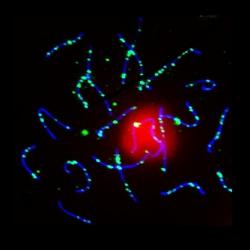The production of gametes involves a crossover exchange between
chromosomes that is necessary to create diversity within sexual species and to
promote their adaptation to the environment. This exchange is the result of
meiosis, a particular type of cell division that is specific to the pool of germ
cells [1] that ultimately become the spermatozoa or egg cells. Besides this
crossover, meiosis allows halving the number of chromosomes (from 46 to 23 in
humans) in the gametes, such that when they unite with their partners from the
opposite sex, cells are formed that integrate the gene pool of both parents. If
this reduction in genetic material goes bad, monosomy [2] or trisomy [3]
abnormalities appear, notably trisomy 21. Infertility is also possible.
A team from the CEA-IRCM, specializing in the mechanisms of meiosis, has
discovered a protein essential to its smooth execution. Named MEIOB [4],
it is found in all vertebrates. The researchers tracked, using antibody
staining, the movements of MEIOB to show that it intervenes during the mixing of
chromosomes, specifically when strands of chromosomes randomly rearrange
themselves together by a phenomenon known as “homologous recombination”.
Additionally, studies on transgenic mice that lack the gene encoding the MEIOB
protein demonstrated that its absence blocks meiosis. The male and female mice
then turn out to be sterile.
 |
Fluorescence imagery on a spread of male mice meiotic chromosomes
(spermatocytes). MEIOB is marked green, and the chromosome axes are in
blue (Sycp3). In red, the sex vesicle that contains non-paired X and Y
chromosomes. |
This discovery could have implications for the diagnosis of
infertilities, through the search for mutations in the MEIOB gene. It will
also undoubtedly advance the understanding of the DNA repair mechanisms in which
MEIOB is involved and that we find altered in many diseases, including certain
cancers.
[1]
The germ cells are the source of gametes. All other cells in sexually
reproducing beings are called somatic cells. These latter cells divide
only by mitosis, to form two daughter cells identical to the mother cell.
[2] The lack of a chromosome.
[3] One of the chromosome pairs becomes triplet.
[4]
Meiosis Specific with OB domain.